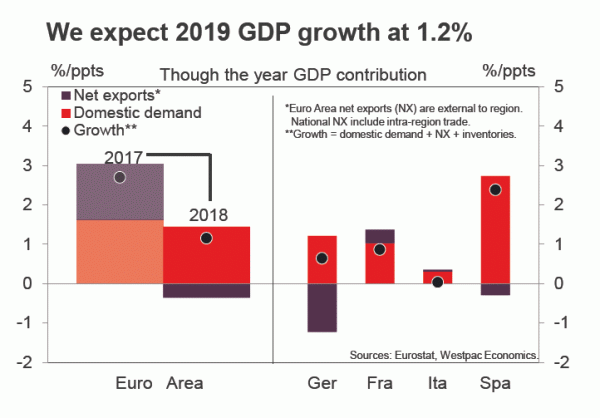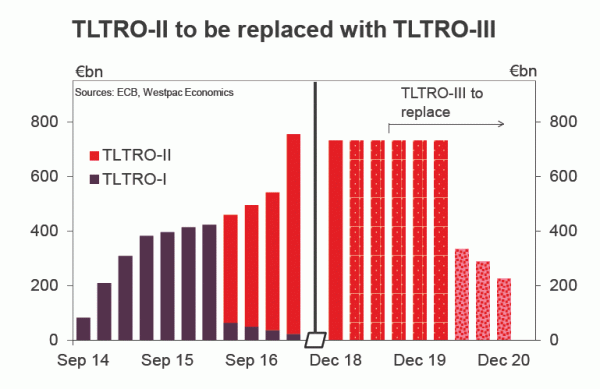The April ECB meeting was a quiet one. Given that it occurred only 35 days after the March meeting, when a significant dovish shift took place, very few had high expectations for an exciting April ECB meeting (a non-projection meeting). The only new addition of substance regarded the negative deposit rate – to which we cover some of the recent research debate below – but most of April’s discussion was about confirming the adjusted policy stance set out in March – so we will begin with that.
To recap March: the ECB made large downward revisions to the economic projections (growth now seen at 1.1% in 2019), extended interest rate policy forward guidance to rates expected to be on hold at least through the end of 2019, and announced a new Targeted Long-Term Refinancing Operations (TLTRO) package in response to the upcoming maturities.
In April, the ECB Governing Council note the new information since March has confirmed slower growth momentum extending into the current year. Again, they note while idiosyncratic domestic factors appear to be fading, global headwinds continue to weigh on Europe. Of most importance, the ECB continues to believe risks are tilted to the downside, citing the long list of uncertainties, which are nearly all geopolitical in nature.
Full detail on the new TLTRO package is still yet to be announced. At first glance TLTRO-III appears less favourable than its predecessor, but the ECB has indicated that there will be incentives (as there were in TLTRO-II). At the April meeting, Draghi indicated that the decision on TLTRO-III pricing will take into account the bank transmission channel and the overall economic outlook. Wording on the announcement date was also adjusted slightly to ‘at one of our forthcoming meetings’ as opposed to ‘in due course’. We expect an announcement in June but the September start date for the package means the ECB could wait until the July or September meetings instead.
Now in regards to the negative deposit rate, the April statement added a new line: ‘In the context of our regular assessment, we will also consider whether the preservation of the favourable implications of negative interest rates for the economy requires the mitigation of their possible side effects, if any, on bank intermediation.’
Of course, this relates to the recent discussion on the potential for the ECB to move to a tiered deposit rate. This would mean only a smaller portion of excess reserves would be charged the negative rate. As banks have been unable to pass on negative deposit rates to households, this would therefore reduce the overall cost paid by banks to the ECB.
Indeed the cost burden on banks is a hotly debated topic in the literature, as noted above by the ECB as having ‘possible side effects’. Indeed, in this year alone, two influential papers offer opposing viewpoints on the matter.
On the affirmative, the paper by Summers, Eggertsson, Juelsrud, and Wold study the effect of negative interest rates on the bank-lending channel in Sweden. They find that while the first two cuts by the Riksbank into negative territory were transmitted to lending rates, the second two cuts to -0.35% and -0.5% respectively had the opposite effect. Their assessment suggests that a policy rate of -0.50 percent increases borrowing rates by 15 basis points.
To the contrary, a paper by the ECB themselves by Amzallag, Calza, Georgarakos and Sousa finds that the aggregate economic implications are small based on analysis of the situation in Italy. However, they do note that there is variance amongst banks due to differences in funding. Banks with a higher proportion of overnight deposits to total assets tend to charge higher rates on fixed mortgages and are more likely to originate adjustable mortgages.
Unsurprisingly, Draghi’s discussion during the press conferences have tended to favour the view of the ECB research, noting that there are numerous drivers of European bank profitability and that in aggregate, it is higher than in the UK where policy rates are positive. He does though acknowledge that there may be side effects that vary by bank.
Overall, the discussion on a tiered deposit rate within the ECB is still in its early stages. Circling back to some of Summers’ earlier work on secular stagnation, it is worth noting European population growth is low at 0.2% per year, implying a low neutral interest rate. If anything, the recent debate on a tiered deposit rate underscores the ECB’s acknowledgement of rates being ‘low for longer’.
In the here and now, we expect the ECB to favour other policy tools if economic conditions were to worsen (such as the incentives on TLTRO) and we do not expect a tiered deposit rate to be announced in the near-term. Nonetheless, it remains an interesting topic as we watch to see whether European growth stabilises in the second half of 2019, as we currently anticipate.















